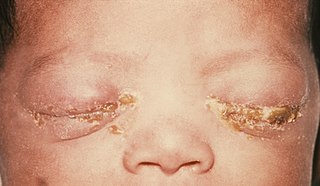
Neomycin is an aminoglycoside antibiotic that displays bactericidal activity against gram-negative aerobic bacilli and some anaerobic bacilli where resistance has not yet arisen. It is generally not effective against gram-positive bacilli and anaerobic gram-negative bacilli. Neomycin comes in oral and topical formulations, including creams, ointments, and eyedrops. Neomycin belongs to the aminoglycoside class of antibiotics that contain two or more amino sugars connected by glycosidic bonds.

Folliculitis is the infection and inflammation of one or more hair follicles. The condition may occur anywhere on hair-covered skin. The rash may appear as pimples that come to white tips on the face, chest, back, arms, legs, buttocks, or head.

Polymyxins are antibiotics. Polymyxins B and E are used in the treatment of Gram-negative bacterial infections. They work mostly by breaking up the bacterial cell membrane. They are part of a broader class of molecules called nonribosomal peptides.

Bacitracin is a polypeptide antibiotic. It is a mixture of related cyclic peptides produced by Bacillus licheniformis bacteria, that was first isolated from the variety "Tracy I" in 1945. These peptides disrupt gram-positive bacteria by interfering with cell wall and peptidoglycan synthesis.
Neomycin/polymyxin B/bacitracin, also known as triple antibiotic ointment, is an antibiotic medication used to reduce the risk of infections following minor skin injuries. It contains the three antibiotics neomycin, polymyxin B, and bacitracin. It is for topical use.

Corneal abrasion is a scratch to the surface of the cornea of the eye. Symptoms include pain, redness, light sensitivity, and a feeling like a foreign body is in the eye. Most people recover completely within three days.

Burkholderia cepacia complex (BCC), or simply Burkholderia cepacia, is a group of catalase-producing, lactose-nonfermenting, Gram-negative bacteria composed of at least 20 different species, including B. cepacia, B. multivorans, B. cenocepacia, B. vietnamiensis, B. stabilis, B. ambifaria, B. dolosa, B. anthina, B. pyrrocinia and B. ubonensis. B. cepacia is an opportunistic human pathogen that most often causes pneumonia in immunocompromised individuals with underlying lung disease. Patients with sickle-cell haemoglobinopathies are also at risk. The species complex also attacks young onion and tobacco plants, and displays a remarkable ability to digest oil. Burkholderia cepacia is also found in marine environments and some strains of Burkholderia cepacia can tolerate high salinity. S.I. Paul et al. (2021) isolated and biochemically characterized salt tolerant strains of Burkholderia cepacia from marine sponges of Saint Martin's Island of the Bay of Bengal, Bangladesh.

Amikacin is an antibiotic medication used for a number of bacterial infections. This includes joint infections, intra-abdominal infections, meningitis, pneumonia, sepsis, and urinary tract infections. It is also used for the treatment of multidrug-resistant tuberculosis. It is used by injection into a vein using an IV or into a muscle.

Allergic contact dermatitis (ACD) is a form of contact dermatitis that is the manifestation of an allergic response caused by contact with a substance; the other type being irritant contact dermatitis (ICD).

Neonatal conjunctivitis is a form of conjunctivitis which affects newborn babies following birth. It is typically due to neonatal bacterial infection, although it can also be non-infectious. Infectious neonatal conjunctivitis is typically contracted during vaginal delivery from exposure to bacteria from the birth canal, most commonly Neisseria gonorrhoeae or Chlamydia trachomatis.
Anusol is a brand of medications that can be used to treat hemorrhoids. The Anusol range includes creams, ointments, and suppositories. Anusol is now known under the brand name Tucks in the United States and some other areas, while being marketed under the Anusol name in other markets. The active ingredients and usage remains unchanged between these brand names.

Capreomycin is an antibiotic which is given in combination with other antibiotics for the treatment of tuberculosis. Specifically it is a second line treatment used for active drug resistant tuberculosis. It is given by injection into a vein or muscle.

Polymyxin B, sold under the brand name Poly-Rx among others, is an antibiotic used to treat meningitis, pneumonia, sepsis, and urinary tract infections. While it is useful for many Gram negative infections, it is not useful for Gram positive infections. It can be given by injection into a vein, muscle, or cerebrospinal fluid or inhaled. The injectable form is generally only used if other options are not available. It is also available as the combinations bacitracin/polymyxin B and neomycin/polymyxin B/bacitracin for use on the skin.

Cyclic peptides are polypeptide chains which contain a circular sequence of bonds. This can be through a connection between the amino and carboxyl ends of the peptide, for example in cyclosporin; a connection between the amino end and a side chain, for example in bacitracin; the carboxyl end and a side chain, for example in colistin; or two side chains or more complicated arrangements, for example in alpha-amanitin. Many cyclic peptides have been discovered in nature and many others have been synthesized in the laboratory. Their length ranges from just two amino acid residues to hundreds. In nature they are frequently antimicrobial or toxic; in medicine they have various applications, for example as antibiotics and immunosuppressive agents. Thin-Layer Chromatography (TLC) is a convenient method to detect cyclic peptides in crude extract from bio-mass.
Pramocaine is a topical anesthetic discovered at Abbott Laboratories in 1953 and used as an antipruritic. During research and development, pramocaine hydrochloride stood out among a series of alkoxy aryl alkamine ethers as an especially good topical local anesthetic agent. Pharmacologic study revealed it to be potent and of low acute and subacute toxicity, well tolerated by most mucous membranes and of a low sensitizing index in humans. Like other local anesthetics, pramocaine decreases the permeability of neuronal membranes to sodium ions, blocking both initiation and conduction of nerve impulses. Depolarization and repolarization of excitable neural membranes is thus inhibited, leading to numbness.

Tyrothricin is an antibiotic mixture which was isolated from Bacillus brevis by Rene Dubos in the late 1930s. It was later shown by Dubos and Rollin Hotchkiss to be a mixture of two different antibiotics: gramicidin and tyrocidine.

Polypeptide antibiotics are a chemically diverse class of anti-infective and antitumor antibiotics containing non-protein polypeptide chains. Examples of this class include actinomycin, bacitracin, colistin, and polymyxin B. Actinomycin-D has found use in cancer chemotherapy. Most other polypeptide antibiotics are too toxic for systemic administration, but can safely be administered topically to the skin as an antiseptic for shallow cuts and abrasions.
Farrell's medium is a selective bacteriological medium for Brucella species which is prepared by the addition of six antibiotics to a basal bacteriological medium such as serum dextrose agar. In order to prepare 1 liter of the Farrell's medium, the following quantities are added to 1 liter of serum dextrose agar: polymyxin B sulfate, bacitracin, natamycin (50 mg), nalidixic acid (5 mg), nystatin, and vancomycin (20 mg). Vancomycin inhibits the growth of gram-positive bacteria on this medium, while nystatin inhibits the growth of fungi. Other antibiotics inhibit the growth of gram-negative bacteria other than Brucella species, thus favoring the exclusive growth of the latter in this medium.

Topical hydrocortisone is a drug under the class of corticosteroids, which is used for the treatment of skin inflammation, itchiness and allergies. Some examples include insect bites, dermatitis and rash.














